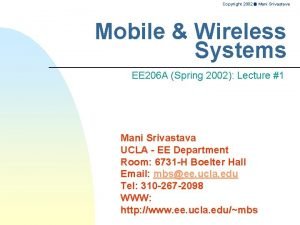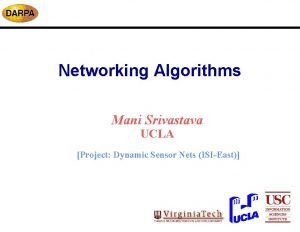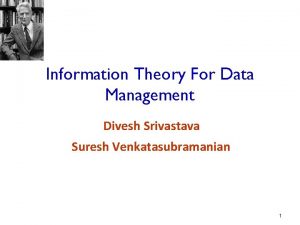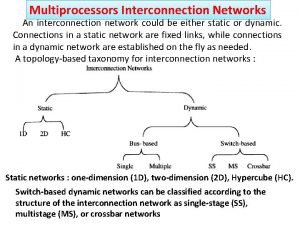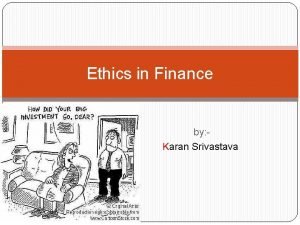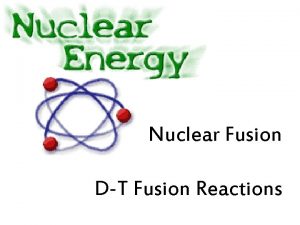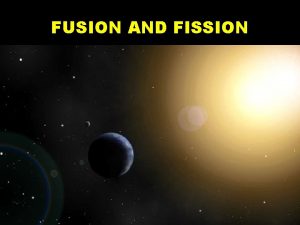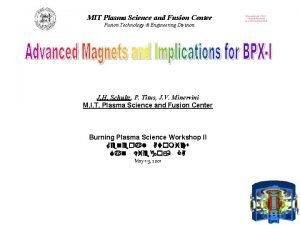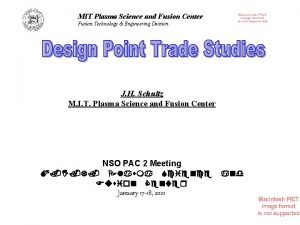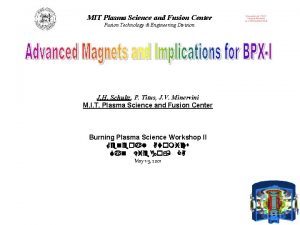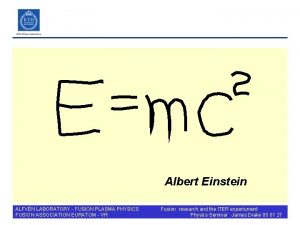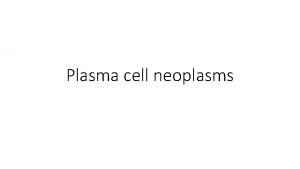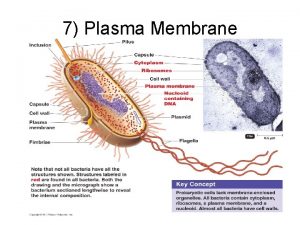High Field in Plasma Fusion Umang Srivastava 2008














- Slides: 14

High Field in Plasma Fusion Umang Srivastava 2008 ee 20403

Fusion Energy

Terminology • Central Electron Density(η) The electron density is the number of electrons per unit volume. • Energy Confinement Time Characteristic time in which 1/2 of a system's energy is lost to its surroundings • Lawson Criterion Scientific breakeven criterion when the fusion output power is large enough to offset energy losses.

Requirements for Fusion • High Temperatures • Adequate Densities • Adequate Confinement • Lawson Criterion: nt > 1020 s/m 3

Confinement approaches to fusion

Two Practical Approaches • Inertial Confinement: – n 1030 / m 3 – t 10 -10 s • Magnetic Confinement: – n 1020 / m 3 –t 1 s

Historical overview • By Mid 1950 s, Lawson criterion had been formulated • Then, two major approaches to fusion energy, – inertial confinement fusion and – magnetic confinement fusion. • inertial confinement fusion energy, – an intense pulse of radiation or particles implodes a spherical fuel pellet producing the temperatures required for fusion, and the reacting fuel is maintained by its inertia

Magnetic Confinement • Generating fusion power that uses magnetic fields to confine the hot fusion fuel in the form of a plasma. • more highly developed , considered more promising for energy production • Uses the electrical conductivity of plasma to confine it within the magnetic field

Plasma • Most common state of matter in the universe • plasma is a state of matter similar to gas in which a certain portion of the particles are ionized • makes the plasma electrically conductive so that it responds strongly to electromagnetic fields • It can be enclosed but unlike gas under the influence of a magnetic field

Tokamak • It is a device using a magnetic field to confine a plasma in the shape of a torus. • Requires magnetic field lines that move around the torus in a helical shape. • the toroidal field is produced by electromagnets that surround the torus, and • the poloidal field is the result of a toroidal electric current that flows inside the plasma (the toroidal current is generated by a second set of electromagnets)

Electrical Power Generation • Tokomak must be operated at or nearly at ignition. (Ignition occurs when the self heating of the plasma by alpha particles generated by the fusion reactors maintains the plasma temperature against all energy losses. ) • ITER is being developed in France which has the power generation capability of 500 MW • In India, a Tokomak is present (SST-1) but is not capable of producing electricity.

Use of high intensity Magnetic Field • Significantly reducing the size of ignited tokamak reactors • increasing the fusion power density and of facilitating reactor maintenance by allowing for a reduction in the complexity of the overall magnetics system

New Researches • Researchers at Lawrenceville Plasma Physics in Middlesex, NJ heated and confined an ionized gas at record temperatures • which would be high enough to allow for the nuclear fusion of certain elements, including hydrogen and boron. • Those elements double as aneutronic fuels — that is, they produce no neutrons during the fusion process — and could thus be quickly converted to electricity without using the expensive and dangerous conversion measures

Thank You
 2008 2008
2008 2008 Rajeev srivastava iit bhu
Rajeev srivastava iit bhu Mani srivastava
Mani srivastava Anshul srivastava production
Anshul srivastava production Divesh srivastava
Divesh srivastava Mani srivastava
Mani srivastava Lara srivastava
Lara srivastava Dynamic interconnection network are
Dynamic interconnection network are Lara srivastava
Lara srivastava Karan srivastava md
Karan srivastava md Diane srivastava
Diane srivastava 2008 middle school fashion
2008 middle school fashion Electric field and magnetic field difference
Electric field and magnetic field difference Individual differences in second language learning
Individual differences in second language learning Field dependent vs field independent
Field dependent vs field independent


